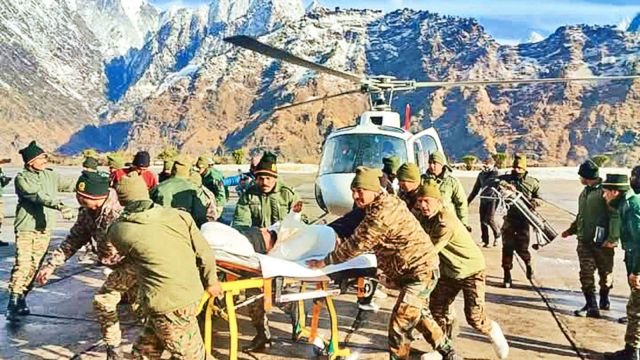
To locate the three containers, Army sniffer dogs have been deployed, and three teams are conducting intensive patrolling, officials say. A Ground Penetrating Radar has been ordered from Delhi to detect containers buried under the snow.
The containers – steel boxes where the workers stayed put when snow came crashing down – were able to withstand the wrecking avalanche and unrelenting weather, which is why a majority of men could be saved, rescuers say.
According to sources, the men were working on a project to connect Mana village to Mana Pass through Badrinath. Lt Colonel Manish Srivastava, the spokesperson for the Indian Army in Uttarakhand, said the workers were part of a team involved in the Shivalik Project of the BRO, which deals with infrastructure in the Garhwal region.
The BRO has been constructing roads in Mana near the Indo-China border, and workers would clear snow, tar the road, and operate machines to make the roads accessible for the forces stationed there. Project Shivalik has also involved the construction of road infrastructure as part of the Char Dham Pariyojna.
Story continues below this ad
Srivastava said the containers helped the men survive the cold and snow. “Had it been tents, they would not have lived,” he said.
The containers used by the Army and the BRO in high-altitude areas have one passage for entry and exit and are made of steel. “These help block the first impact of sudden precipitation of snow and have been in use for some time. We also have routine assessments before setting up camp to ensure they are not in areas with a high risk of avalanches. However, it is also not in the hands of humans,” said a source.
Colonel Ajay Kothiyal, a mountaineer and former principal of Nehru Institute of Mountaineering who had an instrumental role in the rescue during the 2013 Kedarnath floods, said that workers usually camp in tents that cannot hold out against the velocity and load of avalanches.
“Containers like these are weatherproof and sealed, which will also lead to depletion in oxygen levels as time passes. However, had they been in tents, they would not have been able to survive after four hours of the incident,” he said.
Story continues below this ad
Though the mobility of such cabins is questionable, the workers must have been using them for a long duration, officials say.
“Usually, Mana is vacated in winter because it is prone to avalanches. However, this time, snowfall was low, the temperature was rising, and the camp stayed put. If a camp is established with tents and fabric and snow settles, the water and temperature make it difficult to retrieve people buried in it,” Kothiyal, a Mount Everest summiter, said.
Dhan Singh Bisht, the father of one of the rescued workers, Naresh Bisht (35), said they talked on Thursday night, and Naresh told him the weather was turbulent with unceasing snowfall. “He said it seemed dangerous, but his container is below the mountains, so we did not think it was serious. He has been there for a year and would show us on video calls. Their container has space for beds, a toilet, and they stay indoors when the weather is bad. It was because of these metallic boxes that they are alive today. He shared the room with three other workers while my nephew, Dikshit, lived in a separate one in the same camp. Naresh operates the machines used for the construction of roads,” he said.
Story continues below this ad
Bisht said that he was having lunch and watching television around 1.30 pm when he learnt of the incident. “We immediately dialled his number but couldn’t get through. Later, it got switched off. In the evening, the helpline number sprung into action, and we were informed that Naresh was rescued and at the hospital. This morning, he called me and said he was fine. My nephew Dikshit, who was in another container, also has been rescued,” he said.
The deceased have been identified as Alok Yadav from Uttarakhand, Manjeet Yadav from Uttar Pradesh, and Jitendra Singh and Mohindra Pal from Himachal Pradesh. The trapped workers are Harmesh Chand from Himachal Pradesh, Ashok from Uttar Pradesh, and Anil Kumar and Arvind Kumar Singh from Uttarakhand.
Environmentalist and former chairperson of the High-Powered Committee on Char Dham Highway project, Ravi Chopra, said avalanches are common in this region. “These places are not inhabited. You cannot work in that area all year round because it gets snowbound. A few years ago, there was an avalanche from Joshimath to Malari Pass, which also led to the death of several road construction workers,” he said.









